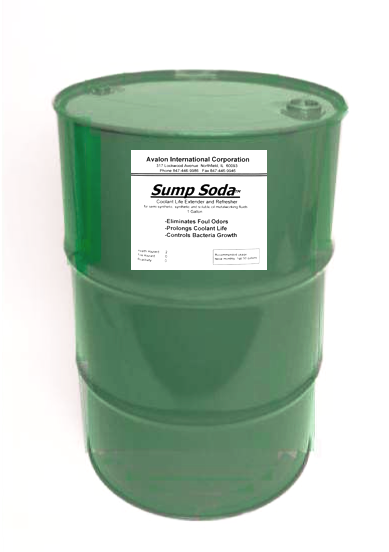Sump Soda® Coolant Additive
End Coolant Odor with Sump Soda® Coolant Additive!
Stop the Stink!
Bugs (bacteria) love coolants and process water. Sump Soda® ends odor. Kills bacteria. Extends coolant life! Stops bacteria! Prevents health issues!
Bacterial and fungal contamination in your coolants cause foul odors, reduce CNC coolant life, create health concerns (dermatitis). Sump Soda® Coolant Conditioner is a simple, convenient and professional-strength, tank-side microbiostat coolant additive for fresher, cleaner-smelling and much longer-lasting machine coolants and process water.
.
- Eliminates foul odors and smells in the shop
- Extends coolant life up to 3x compared to unmanaged sumps
- Fights existing bugs and molds
- Prevents health issues caused by bacteria, such as dermatitis
- Microbiostat bacteria Killer
- Comparative active ingredient to Triadine™ and Triazine.
The following link leads to excerpts from the official OSHA website:
http://www.osha.gov/SLTC/metalworkingfluids/metalworkingfluids_manual.html
Regular bacteria testing allows you to take corrective action that prevents damage to your products, reduces equipment downtime, and prevents employee health issues. Bug Check® BF dip slide test kit is the simple easy-to-use bacteria test kit for counting total bacteria and fungi in all water-based fluids and process water.
Try it today! Bug Check® BF
Dosing Tips:
Bacteria in water-based fluids lowers pH over time, leading to odor, corrosion, and shortened fluid life. Sump Soda kills the bacteria and boosts pH, helping fluids stay cleaner, fresher, and longer-lasting while protecting equipment and part finish.
For most systems, add 1 quart per 50 gallons of coolant or process water. Actual dosage needs will vary with bacterial load — heavily contaminated systems may require additional treatment to bring pH back into range.
Aluminum and other sensitive alloys benefit from a gentler approach: start with ½ quart per 50 gallons, adding in smaller portions spaced about an hour apart. This gradual pH rise keeps levels under 10, minimizing surface staining risk while still delivering all the benefits of Sump Soda.
How Do I Determine When My Coolant is No Longer Safe?
The following signs indicate that a coolant is no longer safe to use and might be hazardous to workers health:
- Foul smell. Uncontrolled microbial growth causes metal working fluid to stink. It is important to address the cause of rancid smells, as the fine spray that is created during machining contains live microbes which can cause harmful health effects (dermatitis) in the employees who are exposed to this coolant mist. Foul smelling fluid is likely caused by microbial growth and needs to be analyzed and treated with biocide. Coolant that cannot be saved should be discarded appropriately. Before adding fresh coolant, the sump needs to be thoroughly cleaned.
- Abnormal fluid appearance. Check the color and appearance of the fluid regularly. Usually, synthetic fluids are clear, often the semi-synthetics appear transparent to milky, and soluble oil typically has a milky appearance with no oil layer. Bacteria often cause coolants to turn grey or black. Tramp oil may cause yellowing and browning of coolants. Colorless coolant is a sign of depleted coolant.
- Employees suffer from respiratory irritation. Exposure to coolant mist that is contaminated by bacteria and fungal spores can lead to irritation and tightness in the chest.
- Employees suffer from dermatitis skin symptoms from working with metalworking fluid, a persistent itchy rash that lasts six months or more.
Stop the Stink with Sump Soda®
This coolant deodorizer is compatible with all major metalworking fluids: Castrol, DA Stuart, Fuchs, ChemTool, Quaker Houghton, Master, AW Chesterton, DoAll, ITW Fluids, Milacron, Hangsterfer's & others.
Comparative active ingredient toTriadine™ and Triazine.
Sump Soda® is a bacteria killer.
-
Sump Soda® - 1 gallon jug; Use 1 qt/50 gal of coolant
Regular price $ 157.00Regular price -
Sump Soda® - 5 gallon pail; Use 1 qt/50 gal of coolant
Regular price $ 550.00Regular price -
Sump Soda® - 55 gallon drum; Use 1 qt/50 gal of coolant
Regular price $ 4,150.00Regular price



